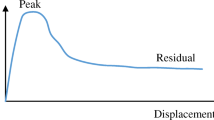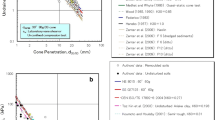Abstract
Slurry–soil interface direct shear (IDS) tests and the triaxial compression (TC) tests are currently used to determine the shear strength of grouted soil. However, many previous studies focused on sandy soils, and limited attention has been paid to clayey soil. This study introduces two grouting test methods designed to fabricate the grouted clay specimen suitable for TC and IDS testing. A group of grouting orthogonal tests is designed, and the shear strength parameters are calculated and compared based on the Mohr–Coulomb (MC) criterion. Findings showed that outcomes obtained from the IDS test are unreliable. The test results showed that the shear strength obtained from IDS test yields more serious deviations and lower MC criterion fitness. The test also showed that shear strength parameters under IDS test are unreliable compared with TC tests. Additionally, the cohesion measured by the IDS test was always larger than that associated with the TC test, which is caused by the extension of the shear surface in the shearing process according to the failure pattern. The overestimation of shear strength in the case of the IDS test decreased the predicted surface settlement, as proved by numerical simulations. The conclusions indicate that using TC tests to obtain accurate shear strengths of grouted clay is crucial for predicting the soil deformation and developing rational construction schemes.














Similar content being viewed by others
Abbreviations
- A d :
-
Shearing area within sample in interface direct shear test
- C :
-
Cohesion
- c c :
-
Cohesion in triaxial compression test
- c d :
-
Cohesion in interface direct shear test
- c g :
-
Cohesion of grouted clay
- e :
-
Void ratio
- P :
-
Grouting pressure
- P 0 :
-
Normal load in interface direct shear test
- P d :
-
Peak shear load or shear load at specified horizontal displacement in interface direct shear test
- R 2 :
-
Fitting coefficient
- W:C :
-
Water–cement ratio
- w :
-
Moisture content
- w L :
-
Liquid limit
- w P :
-
Plastic limit
- ρ :
-
Density
- ρ d :
-
Dry density
- φ :
-
Internal friction angle
- φ c :
-
Internal friction angle in triaxial compression tests
- φ d :
-
Internal friction angle in interface direct shear test
- φ g :
-
Internal friction angle of grouted clay
- σ c :
-
Uniaxial compressive strength
- τ d :
-
Peak shear stress obtained by direct shear test
- σ d :
-
Normal stress in interface direct shear test
- σ 1 :
-
Maximum principal stress in triaxial compression test
- σ 3 :
-
Confining pressure in triaxial compression tests
References
Ajorloo AM, Mroueh H, Lancelot L (2012) Experimental investigation of cement treated sand behavior under triaxial test. Geotech Geol Eng 30:129–143. https://doi.org/10.1007/s10706-011-9455-4
Alejano LR, Carranza-Torres C (2011) An empirical approach for estimating shear strength of decomposed granites in Galicia, Spain. Eng Geol 120:91–102. https://doi.org/10.1016/j.enggeo.2011.04.003
An Q, Zhang Q, Zhang X, Zhang J (2021) Bridging the gap between engineering properties and grouting reinforcement mechanisms for loess in eastern China: taking Jinan loess as an example. Bull Eng Geol Environ 80:4125–4141. https://doi.org/10.1007/s10064-021-02201-w
ASTM D4767–11 (2020) Standard Test Method for Consolidated Undrained Triaxial Compression Test for Cohesive Soils. ASTM International, West Conshohocken, PA
ASTM D6528–17 (2017) Standard Test Method for Consolidated Undrained Direct Simple Shear Testing of Fine Grain Soils. ASTM International, West Conshohocken, PA
Ata A, Vipulanandan C (1999) Factors affecting mechnical and creep properties of silicate-grouted sands. J Geotech Geoenviron Eng 125:868–876. https://doi.org/10.1061/(ASCE)1090-0241(1999)125:10(868)
Attewell PB, Farmer IW (1974) Ground deformations resulting from shield tunnelling in London clay. Can Geotech J 11:380–395. https://doi.org/10.1139/t74-039
Chakeri H, Hasanpour R, Hindistan MA, Ünver B (2011) Analysis of interaction between tunnels in soft ground by 3D numerical modeling. Bull Eng Geol Environ 70:439–448. https://doi.org/10.1007/s10064-010-0333-8
Chieregato A, Oñate Salazar CG, Todaro C et al (2014) Laboratory grouting test for waterproofing and consolidation of granular soils by means of innovative materials. Geoing Ambient e Mineraria 141:63–68
Cooper ML, Chapman DN, Rogers CDF, Chan AHC (2002) Movements in the Piccadilly Line tunnels due to the Heathrow Express construction. Geotechnique 52:243–257. https://doi.org/10.1680/geot.2002.52.4.243
Dammyr Ø, Nilsen B, Gollegger J (2017) Feasibility of tunnel boring through weakness zones in deep Norwegian subsea tunnels. Tunn Undergr Sp Technol 69:133–146. https://doi.org/10.1016/j.tust.2017.06.012
Dano C, Hicher P-Y, Tailliez S (2004) Engineering properties of grouted sands. J Geotech Geoenvironmental Eng 130:328–338. https://doi.org/10.1061/(asce)1090-0241(2004)130:3(328)
Divall S, Goodey RJ, Stallebrass SE (2018) Twin-tunnelling-induced changes to clay stiffness. Tunn Urban Environ 37–44. https://doi.org/10.1680/tue.63778.037
Fang Q, Tai Q, Zhang D, Wong LNY (2016) Ground surface settlements due to construction of closely-spaced twin tunnels with different geometric arrangements. Tunn Undergr Sp Technol 51:144–151. https://doi.org/10.1016/j.tust.2015.10.031
Farrell RP (2015) Tunnelling and compensation grouting at Bond Street, London. Proc Inst Civ Eng Geotech Eng 168:471–482. https://doi.org/10.1680/jgeen.14.00162
Gong F, Luo S, Lin G, Li X (2020) Evaluation of shear strength parameters of rocks by preset angle shear, direct shear and triaxial compression tests. Rock Mech Rock Eng 53:2505–2519. https://doi.org/10.1007/s00603-020-02050-1
Haofeng X, Feng X, Feng Z (2018) Improvement for the strength of salt-rich soft soil reinforced by cement. Mar Georesources Geotechnol 36:38–42. https://doi.org/10.1080/1064119X.2016.1278064
Hossain MA, Yin J-H (2014) Behavior of a pressure-grouted soil–cement interface in direct shear tests. Int J Geomech 14:101–109. https://doi.org/10.1061/(asce)gm.1943-5622.0000301
Hossain MA, Yin JH (2011) Influence of grouting pressure on the behavior of an unsaturated soil-cement interface. J Geotech Geoenvironmental Eng 138:193–202. https://doi.org/10.1061/(ASCE)GT.1943-5606.0000585
Ismail MA, Joer HA, Sim WH, Randolph MF (2002) Effect of cement type on shear behavior of cemented calcareous soil. J Geotech Geoenvironmental Eng 128:520–529. https://doi.org/10.1061/(asce)1090-0241(2002)128:6(520)
Jinpeng Z, Limin L, Futao Z, Junzhi C (2018) Development and application of new composite grouting material for sealing groundwater inflow and reinforcing wall rock in deep mine. Sci Rep 8:1–11. https://doi.org/10.1038/s41598-018-23995-y
Kahraman S, Altun H, Tezekici BS, Fener M (2006) Sawability prediction of carbonate rocks from shear strength parameters using artificial neural networks. Int J Rock Mech Min Sci 43:157–164. https://doi.org/10.1016/j.ijrmms.2005.04.007
Kakavand A, Dabiri R (2018) Experimental study of applying colloidal nano Silica in improving sand-silt mixtures. Int J Nano Dimens 9:357–373
Lee JS, Han WJ, Kim SY, Byun YH (2020) Shear strength and interface friction characteristics of expandable foam grout. Constr Build Mater 249:118719. https://doi.org/10.1016/j.conbuildmat.2020.118719
Li P, Zhang Q, Zhang X et al (2017) Grouting diffusion characteristics in faults considering the interaction of multiple grouting. Int J Geomech 17:1–10. https://doi.org/10.1061/(ASCE)GM.1943-5622.0000815
Markou IN, Atmatzidis DK (2003) Mechanical behavior of a pulverized fly ash grouted sand. Geotech Test J 26:450–460. https://doi.org/10.1520/gtj11252j
Meng F, Chen R, Wu H, Cheng H (2020) Evaluating closely spaced twin-tunnelling-induced shear stiffness change by subsurface settlement in clayey ground. Environ Earth Sci 13:326. https://doi.org/10.1007/s12665-020-09087-z
Moayed RZ, Hosseinali M, Shirkhorshidi SM, Sheibani J (2019) Experimental investigation and constitutive modeling of grout–sand interface. Int J Geomech 19:04019024. https://doi.org/10.1061/(asce)gm.1943-5622.0001384
Murdoch LC (1993) Hydraulic fracturing of soil during laboratory experiments Part 1. Methods and Observations Geotechnique 43:255–265. https://doi.org/10.1680/geot.1993.43.2.255
Nouri Delavar I, Noorzad R (2020) Drained shear strength parameters of silty sand grouted by colloidal silica. Int J Geotech Eng 14:1–8. https://doi.org/10.1080/19386362.2017.1380369
Packer M, Prangley C, Newman R, Heath I (2018) Permeation grouting and excavation at Victoria station, London. Proc Inst Civ Eng Geotech Eng 171:267–281. https://doi.org/10.1680/jgeen.17.00115
Park DS, Oh J (2018) Permeation grouting for remediation of dam cores. Eng Geol 233:63–75. https://doi.org/10.1016/j.enggeo.2017.12.011
Widmann R (1996) International Commission Society for Rock on Rock Grouting. Int J Rock Mech Min Sci Geomech Abstr 33:803–847. https://doi.org/10.1016/S0148-9062(96)00015-0
Saiyouri N, Alaiwa AA, Hicher P-Y (2011) Permeability and porosity improvement of grouted sand. Eur J Environ Civ Eng 15:77–97. https://doi.org/10.1080/19648189.2011.9693307
Schnaid F, Prietto PDM, Consoli NC (2001) Characterization of cemented sand in triaxial compression. J Geotech Geoenvironmental Eng 127:857–868. https://doi.org/10.1061/(ASCE)1090-0241(2001)127:10(857)
Suits LD, Sheahan TC, El Mohtar CS, Rugg DA (2011) New three-way split mold design and experimental procedure for testing soft, grouted soils. Geotech Test J 34:103645. https://doi.org/10.1520/GTJ103645
Todaro C (2021) Grouting of cohesionless soils by means of colloidal nanosilica. Case Stud Constr Mater 15:e00577
Wang YH, Leung SC (2008) Characterization of cemented sand by experimental and numerical investigations. J Geotech Geoenvironmental Eng 134:992–1004. https://doi.org/10.1061/(asce)1090-0241(2008)134:7(992)
Wang W, Pan J, Jin F (2019) Mechanical behavior of cemented granular aggregates under uniaxial compression. J Mater Civ Eng 31:04019047. https://doi.org/10.1061/(asce)mt.1943-5533.0002681
Yuan S, Han G (2020) Combined drilling methods to install grout curtains in a deep underground mine: A case study in Southwest China. Mine Water Environ 39:902–909. https://doi.org/10.1007/s10230-020-00701-x
Zhang DM, Huang ZK, Wang RL et al (2018) Grouting-based treatment of tunnel settlement: Practice in Shanghai. Tunn Undergr Sp Technol 80:181–196. https://doi.org/10.1016/j.tust.2018.06.017
Zhang JP, Liu LM, Li QH et al (2019) Development of cement-based self-stress composite grouting material for reinforcing rock mass and engineering application. Constr Build Mater 201:314–327. https://doi.org/10.1016/j.conbuildmat.2018.12.143
Zhang Q, Li P, Zhang X et al (2015) Model test of grouting strengthening mechanism for fault gouge of tunnel. Yanshilixue Yu Gongcheng Xuebao/Chinese J Rock Mech Eng 34:924–934. https://doi.org/10.13722/j.cnki.jrme.2014.0667
Zhao J (2000) Applicability of Mohr-Coulomb and Hoek-Brown strength criteria to the dynamic strength of brittle rock. Int J Rock Mech Min Sci 37:1115–1121. https://doi.org/10.1016/S1365-1609(00)00049-6
Zhou D, Zhao Z, Li B et al (2020) Permeability evolution of grout infilled fractures subjected to triaxial compression with low confining pressure. Tunn Undergr Sp Technol 104.https://doi.org/10.1016/j.tust.2020.103539
Acknowledgements
The research reported in this manuscript was funded by the National Natural Science Foundation of China (Grant No. U1706223) and by the Fundamental Research Funds for the Central Universities (Grant No. 2019GN079).
Author information
Authors and Affiliations
Corresponding author
Rights and permissions
About this article
Cite this article
Yin, Z., Zhang, Q., Zhang, X. et al. Shear strength of grouted clay: comparison of triaxial tests to direct shear tests. Bull Eng Geol Environ 81, 261 (2022). https://doi.org/10.1007/s10064-022-02739-3
Received:
Accepted:
Published:
DOI: https://doi.org/10.1007/s10064-022-02739-3




